Why Is Food Safety Important In Healthcare? Healthcare Leaders Guide
Learn challenges healthcare foodservice teams face today and key food safety practices to protect vulnerable patients. Get a free healthcare leader...
Food businesses are allowed to serve game meats if they are ranch-raised and regulated by health and wildlife agencies.
The popularity and growth of using game meat as a more sustainable meat source in the food industry have increased significantly. Different types of game meats are becoming more available in the market while being heavily regulated by food safety agencies.
While game meats are traditionally known to be obtained through hunting game animals, the food industry worked its way around this definition and established guidelines for producing farm-raised game meats.
In preparing and serving game meat recipes, the importance of food safety must be emphasized. As growing game animals is entirely different from the usual domesticated farm practices, concerns for public health are also on the rise. To help control food safety issues from serving game meats, food businesses must uphold strict food safety protocols in preparing them.
Learn more about game meats from this article and how our smart Food Safety Management System can help you ensure food safety in preparing game meats.
In this article, we'll cover the following topics:
WHAT WE'LL COVER:
The original game meat meaning refers to the meat obtained from free-ranging animals in their natural habitat, as opposed to being raised on farms.
Since animals that give game meats are often protected by wildlife laws, the food industry came to a solution of creating sustainable conditions to raise game animals in ranch settings. Unlike normal farm operations, game animals raised for food production are allowed to roam the area freely and are not fed with regular corn feeds.
As such, in the food industry, the term game meat refers to animals that are naturally found in the wild but were reproduced and raised in individual ranches with farm conditions. Game animals include species that are not naturally domesticated in common farms. Some common types of meat come from animals, including deer, boar, rabbit, wild duck, or pheasant. The animals are no longer hunted for selling. This type of meat raised in such practices can be legally served in restaurants.
Game meat is known for its distinct taste and tender meat texture as a result of the animal's natural diet. Customers order game meat for its earthy and richer flavors, which are commonly referred to as "gamey flavors." As the animals are free-ranging in a stress-free environment, the flavors of their meat are considered to have more flavor and are even healthier. Game meats add a unique selection of dishes to your restaurant menu.
Local and state food safety agencies regulate restaurants serving game meat to ensure animal welfare, humane practices, and proper handling.
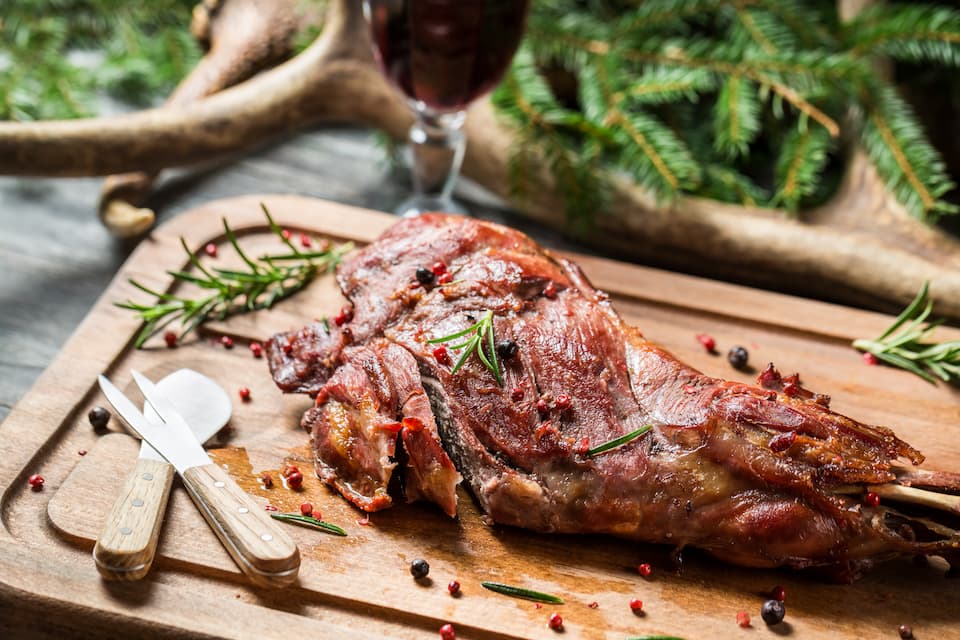
Freshly baked venison
Game meat is also termed wild game meat, and this refers to the meat acquired from animals hunted in their natural habitat. Game animals raised in farm conditions are not called wild meat.
Wild game meats come from animals that live in their natural habitat, such as forests or woodland environments, and are legally obtained for consumption. Animals considered wild game species, or those living in their natural habitat, are protected by federal regulations and can only be consumed for personal means. Wild game animals are subjected to less animal stress because of their environment. Selling wild game meat from independently-owned farms is heavily regulated by food safety and wildlife agencies to protect wildlife resources.
Restrictions and regulations on the hunting and distribution of game meat vary from one state to another. Regulations help ensure the sustainable use of game meat and that they are handled with special care to prevent food safety issues.
Game meats differ in flavor, texture, nutritional content, and recommended handling. These types of meat can be both dark meat and white meat. It means that game meat can be either poultry-based, which gives the white meat, or may come from mammals that give the red meat.
The category of game meat is often considered an entirely different group of meat in the food industry. It includes a diverse list of meats from animals that were originally hunted, as discussed in the next section.
Game meats are known to have earthier flavors and lesser fat content because of the animal's daily activities and living environment. They have also been discovered to be good sources of essential nutrients, such as lean protein, iron, and omega-3 fatty acids.
Securing game meat supply may be harder than the usual type of meat. They are commonly sourced locally and seasonally. As the production of game meats is highly regulated, restaurants often put a higher price on them. Customers in different countries often consider game meat to be more ethical and sustainable compared to conventionally raised meats. They are also generally grown with less medical intervention, such as supplementing growth stimulants, which produce higher-quality products.
Read about the common types of game meat in the next section.
Game meats consist of a very wide list of proteins from different animals. In fact, game meat can be further subdivided into groups of animal sources, including winged, ground, and big games.
Below, we made a game meats list of the common types of game meat that you can see in restaurants, processing facilities, or meat retail and grocery stores.
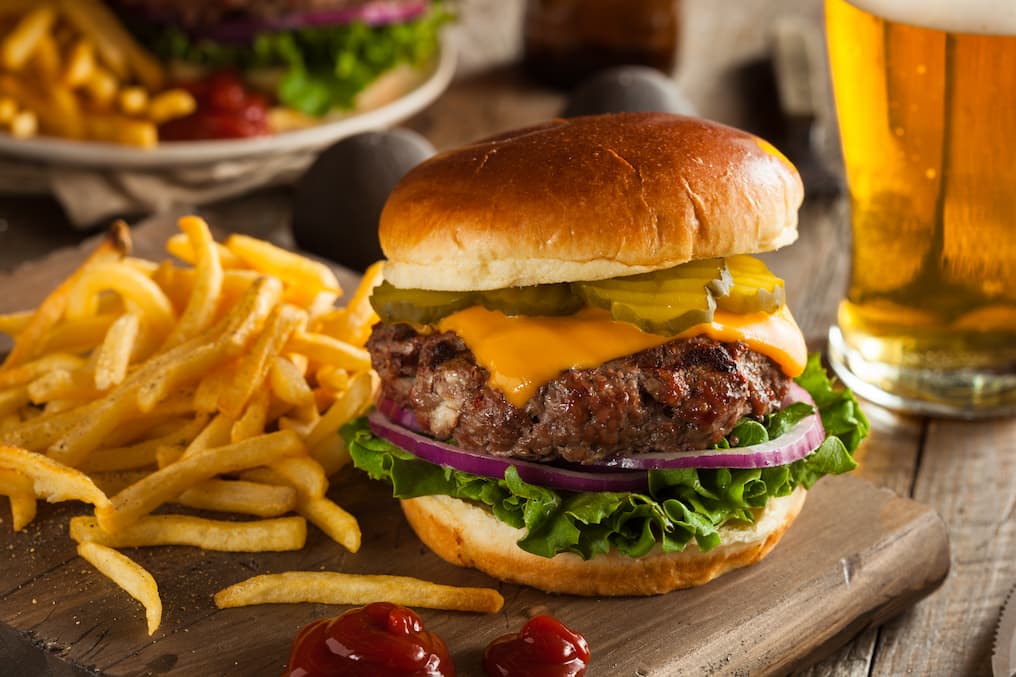
Bison meat used as burger patties
The mentioned list of game meats includes only a few examples. There is a wide variety of game meat that is allowed to be served in restaurants but with regulated processing practices.
Because game meats vary greatly in characteristics, their food handling requirements may also vary. As such, employees and businesses serving game meats must be quick to adapt to the food safety regulations surrounding each type of game meat.
The best way for your to maintain compliance is to use our smart Food Safety Management System from FoodDocs. Using our smart software, you can easily customize automatically generated monitoring logs based on the requirements of each game meat. You can also ensure that your game meats will remain safe for consumption and will not stay past their expiration dates with our built-in Traceability system.
Game animals are wild animals hunted for sport or consumption. This term was coined in the early times when hunters and gatherers originally hunted for animals in the wild. In the past, hunting wild animals was considered a sport or recreational activity, and the hunted animals served as their trophies.
The list of animals that can be considered "game animals" largely varies depending on regional and cultural contexts and local jurisdictions. Game animals include land animals, birds, and fish. Animals in this category are commonly subdivided into different categories.
Game animals can be divided based on their size.
Wildlife services protect game animals. Hunting for them requires appropriate licenses. Wildlife agencies often regulate them based on bag limit, season, and licensing requirements to ensure sustainable practices and ethical hunting.
While gaining popularity, the use of game animals for food service has also faced food safety concerns. Consumers were found to be concerned about the potential food safety hazards that come with free-ranging animals. Concerns included the presence of infectious parasites, an increase in cholesterol, and the presence of heavy metals from foraging plants in the environment.
In food services, food safety is enforced by federal agencies. To protect public health, game meats, including those raised for food service, must undergo strict inspections by the Food and Drug Administration (FDA), Centers for Disease Control and Prevention (CDC), the U.S. Department of Agriculture's Animal and Plant Health Inspection Service (APHIS), and the U.S. Fish and Wildlife Service (USFWS).
Although basically meat, game meat is not under the jurisdiction of USDA's Poultry Products Inspection Act and Federal Meat Inspection Act. As such, selling and preparing of game meats are under the food safety requirements of the FDA. This means that all food businesses serving game meat must comply with food safety and wildlife regulations.
The term "gamey meat" or the gamey taste meaning is associated with the distinct flavor and aroma of game meat. This profile is described as strong, musky, earthy, and gamy. It is very different from the flavor that you get from domesticated animals, including beef, chicken, or pork.
The unique quality and gamey meat flavor are the results of different factors associated with free-ranging animals. The natural diet of game animals is very different from domesticated ones. Domesticated animals normally just eat corn or products in grain diet and similar types of feed, whereas game animals are allowed to roam around and search for their food. Their food search, the diet of grass, and other activities also make their meat leaner and have an earthier flavor. As such, the quality of pasture will determine the resulting taste of game meat.
While others enjoy the gamey taste, some customers do not favor it. Proper handling, aging, and cooking can be done to tone down the flavor. The gamey meat flavor is not an indicator of the food's freshness or safety.
Ranched or farm-raised game meat can be served in U.S. restaurants. On the other hand, wild game meat that is manually hunted is not legally allowed to be sold.
Even farm-raised game meat stocks require strict inspection by the Federal Government. Depending on the state and local laws, other restrictions on selling game meat may be present. Some states may prohibit the sale of particular game meats that are considered endangered.
It is also important to note that suppliers of game meat are very uncommon. This means that shipping costs, logistics, and overall expenditures will be higher.
Serving game meat in restaurants will require you to disclose information, such as the origin of the meat, the concerned ranch, and the inspection processes that it has gone through. Transparency is important when it comes to serving game meat.
Store inspection reports, audits, and certifications from food safety agencies in our cloud-based system. Access them anytime and show them to your inspectors as proof of compliance.
Yes, wild game and exotic animal meat is legal to serve in retail food establishments if it is inspected and approved by relevant food safety and wildlife regulatory agencies, obtained from licensed suppliers who adhere to strict health and safety guidelines, and properly processed under controlled conditions to ensure it meets all legal and food safety standards.
Additionally, the meat must be properly labeled, and the establishment must comply with all local, state, and federal regulations regarding the sale and serving of game and exotic meats.
Serving game meat entails strict food safety measures. The widely unconventional raising conditions of regulated game meat farms, as opposed to domesticated meat, raise many food safety concerns among consumers. Although game meats served in food service establishments are highly regulated, their high exposure to the environment makes them vulnerable to diseases and parasites.
Below, we discuss some of the common food safety issues concerning game meat.
These are just some prominent food safety issues surrounding the use of game meats. Other issues, such as sustainability and ethical concerns, have also been identified by the food industry.
In solving food safety issues, the key operations are to undergo strict inspection and carefully prepare game meats. Careful preparation includes their proper storage and cooking to the appropriate cooking temperature. Food businesses must ensure that their sources of game meat also uphold the same level of food safety compliance as you do. Check out our free cooking temperature charts for 12 different meats to ensure food safety compliance when preparing your dishes.
As the types of meat included in the game meat category is very diverse, their shelf-life also greatly varies. In general,game meats are recommended to be used within 3 to 5 days of purchase.
Game meats must be properly refrigerated at a temperature range of 40°F (4°C) or below. You can further prolong the shelf-life of game meats to at least 8 months to a year if you freeze them at 0°F (-18°C) or below. Frozen meat can stay fresh and safe for consumption for a longer time.
A critical factor in ensuring the shelf-life of game meats is their quality. Game meats are considered high-risk and are part of the TCS group or time/temperature control for safety group. Game meats must be transported in refrigerated conditions to ensure safety upon receipt.
Use our digital monitoring logs from FoodDocs, such as our Receiving Chilled Goods Log and Fridge Temperature Log, to ensure that your game meat ingredients are received and stored in the correct conditions.

Fridge temperature log from FoodDocs
In this context, we talk about handling game meat that is intended to be sold at a restaurant. This means that processing practices such as field dressing or the skinning and cleaning of meat are already taken care of by the supplier.
Like other domestic meat, game meats require proper handling to avoid food contamination and potentially cross-contaminating other ingredients in the kitchen.
Here are some essential food safety guidelines for handling game meat in a restaurant kitchen:
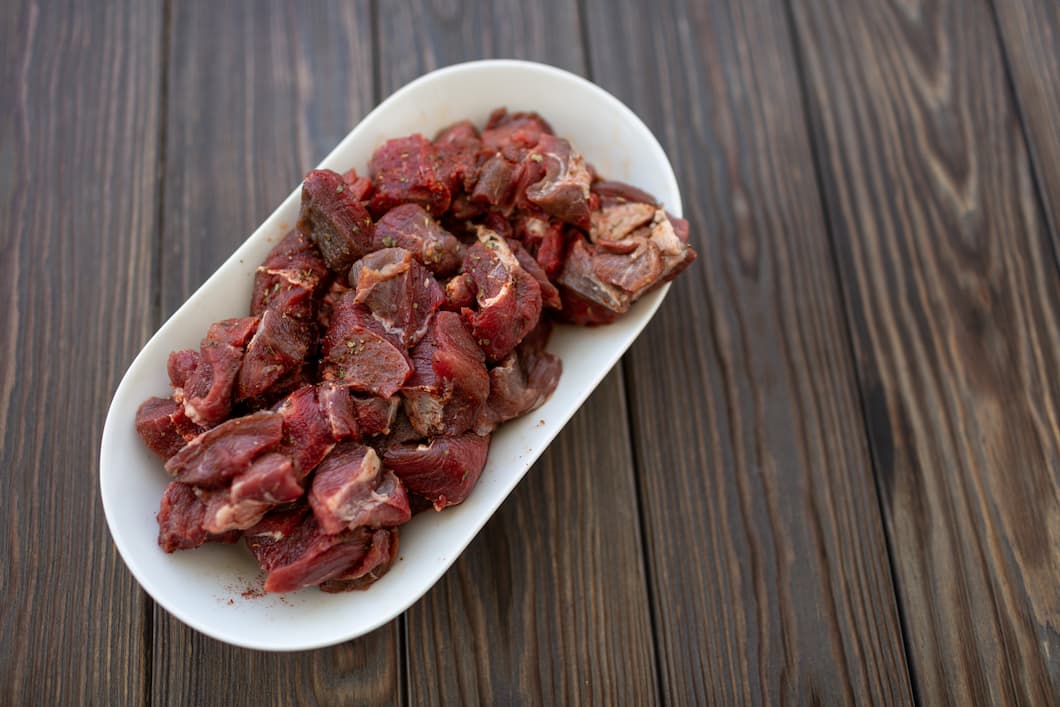
Raw game meat from wild boar
Consistent monitoring of the movement of your game meat ingredients in the kitchen will help ensure safety. Doing so will take so much of your time and will keep you from improving your business performance.
Now, you can intuitively monitor and keep track of your product and ingredients' movement across your operations. Our smart Food Safety Management System comes with a Production Management Solution. Use this feature to monitor and optimize your production and avoid problems, such as stock-outs. This way, you can save around 20% of your time on food safety tasks.
Properly cooking game meat will depend on the nature of the game animal. As previously mentioned, game meats vary in characteristics significantly. Large game meats, including elk, moose, venison, bison, and wild boar, are recommended to be cooked to an internal temperature of 160°F (71°C). This internal temperature will give your large game meat a well-done level of doneness.
Similarly, ground meat must be cooked to an internal temperature of 160°F (71°C). In the case of meat from flying game animals, the recommended cooking temperature is set at 165°F (74°C). It is important to note that a properly calibrated meat thermometer must accompany the cooking process for game meat products.
Undercooking game meats increases the risk of causing foodborne illnesses in consumers. A common foodborne illness-causing parasite is Trichinella spiralis. This parasite can induce fevers, cough, swelling of the face, abdominal pain, and diarrhea in affected consumers. Trichinella parasite can be easily removed if the game meat is cooked to the recommended internal temperature. It is also important to remember that washing meat isn't necessary before cooking as this will only increase the risk of spreading the parasite in the kitchen.
Use our charts for meat cooking temperatures to guide your employees on the proper cooking conditions of game meats.
Game meats are increasingly becoming popular in the food service industry. More and more consumers and food businesses realize game meat's potential as a sustainable replacement for domesticated meat. To satisfy consumer demand for game meat, food business owners must adapt to the requirements of handling this type of meat.
The fastest way to adapt to new food safety regulations, such as in handling game meats, is to use an intuitive solution. Use FoodDocs' smart Food Safety Management System to effortlessly set up your monitoring system in just an average of 15 minutes.
Powered by artificial intelligence, our smart software can help you intuitively monitor handling practices for game meats. You can get the following benefits:

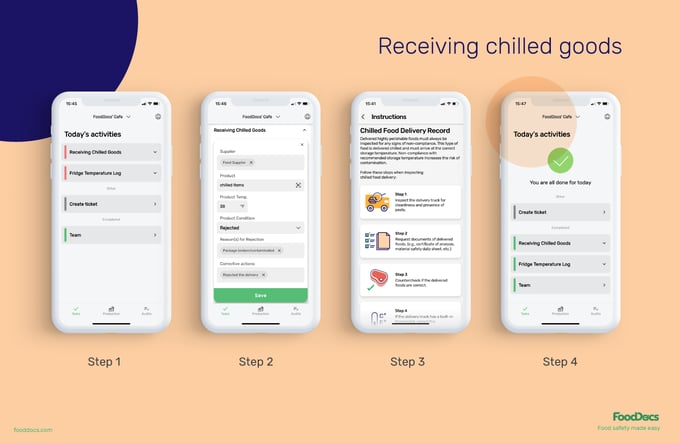

Production Traceability System from FoodDocs
Our smart software also offers solutions for food safety managers. You can improve the efficiency of your operations with features from our smart Food Safety Management System.
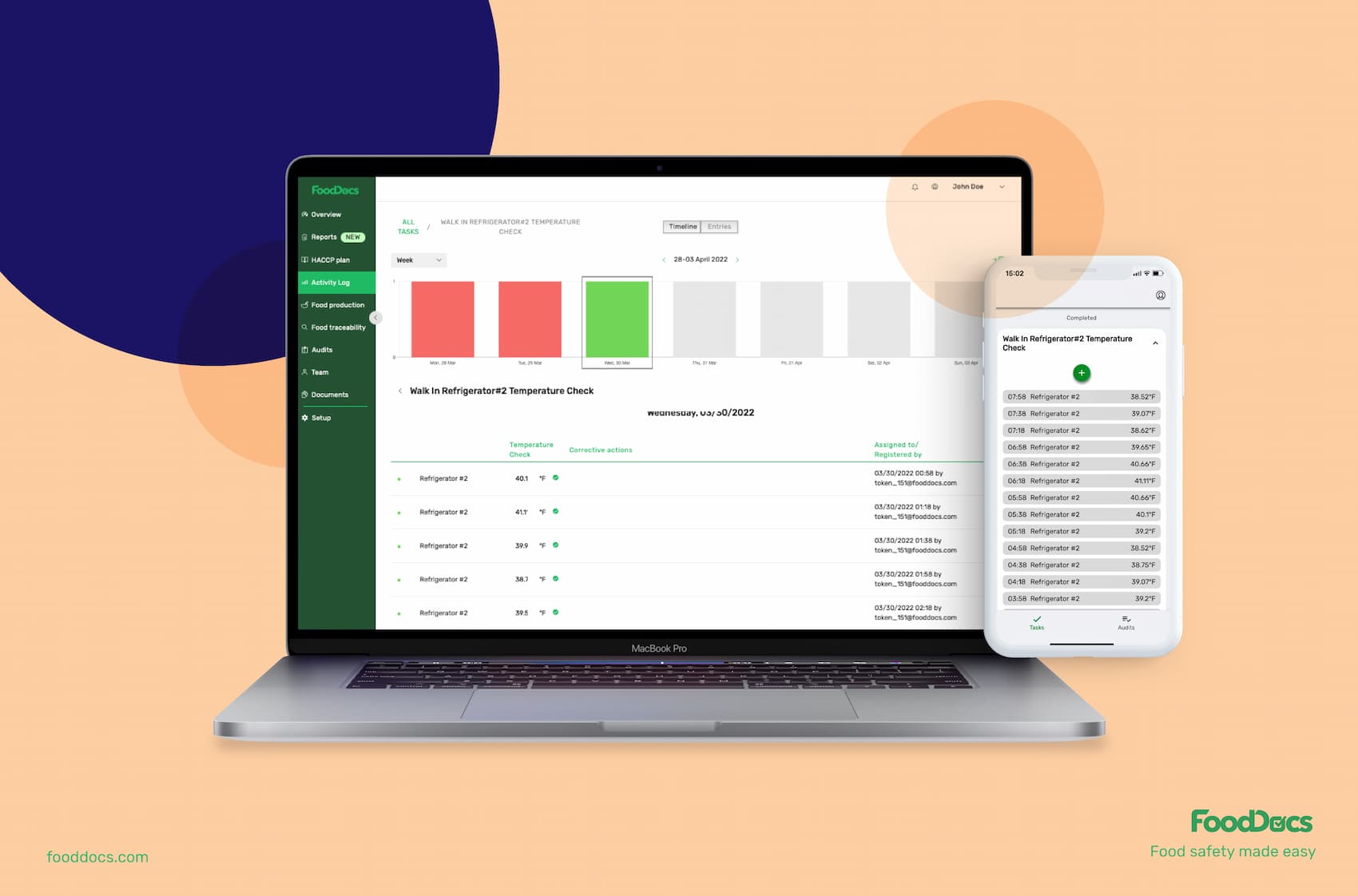
Real-time dashboard from FoodDocs
Our smart software is the best digital solution for food businesses. You can easily adapt to the fast-paced industry with our smart software. Apply changes and improvements with a few clicks, as our monitoring logs and checklists are all customizable to further fit your requirements.
Powered by artificial intelligence and a machine-learning program, your food business can maintain food safety compliance in the most efficient manner with the help of our software.
Start monitoring your operations and tracking your production tasks digitally by using our free 14-day trial.
Do you have more questions about game meats? We gathered a few of the most frequently asked questions about game meats and answered them for you.
Yes. Venison refers to the game meat obtained from deer.
Although widely available and less regulated, wild duck is considered game meat. It is part of the winged game or game bird category of meat alongside goose, partridge, quail, and pheasant.
Six (6) examples of common game meat types include bison, deer, wild boar, rabbit, pigeon, and quail.
Game meat refers to the meat obtained from animals that are normally found in the wild and uncommonly domesticated. On the other hand, regular meat comes from domestic animals or farm-raised animals, like pigs, sheep, and cows.
In recent times, the food supply industry has come up with a setup of nurturing game animals in a free-ranging setup. This helps protect wildlife from illegal hunting for game meat.
Large, land game meats, such as venison and bison, can be eaten rare. Although, consuming rarer game meats can have negative effects on consumers with weakened immune systems. Undercooked game meat has a higher chance of causing foodborne illness in consumers.
Learn challenges healthcare foodservice teams face today and key food safety practices to protect vulnerable patients. Get a free healthcare leader...
Learn what Standard Operating Procedures (SOPs) are and how to write effective SOPs that ensure consistency, efficiency, and safety in your...
Boost your retail food safety with essential practices and digital tools to protect customers and your brand. Plus a free Retail Food Safety Leader...